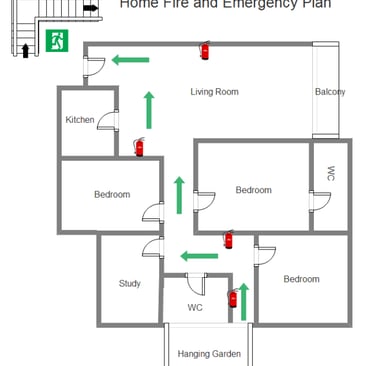Fire-Related Issues at Home
E.D.I.T.H. (Escape Drills in the Home)
Draw a floor plan of your home and mark two exits for each room. Pick a safe meeting spot outside and practice the plan with your family regularly
Teach everyone how to unlock doors and windows, keep exits clear, and recognize the sound of a smoke detector. Run fire drills at least twice a year.
If you're in an apartment or high-rise, learn the building’s evacuation plan. Use stairs—never elevators—and report blocked exits. If trapped, seal cracks with a wet cloth, call 911, and signal for help from a window.
During a fire, stay low to avoid smoke. Test doors with the back of your hand—if hot, use another route. If cool, open slowly and close behind you to slow the fire.
Preparation saves lives. Plan ahead. Practice often. Stay safe.
Smoke Detectors
Did you know smoke detectors should be replaced every 10 years? Aging detectors lose effectiveness, so replacing them helps protect your family and provides access to newer technology.
For optimal protection, install smoke detectors on every level of your home and within 15 feet of bedrooms. Larger homes require more detectors for adequate coverage. Mount them in the center of the ceiling, away from drafts, and at least 10 feet from stoves and showers to avoid false alarms.
The leading cause of non-operational smoke detectors is dead or missing batteries. Test detectors monthly, and replace batteries during daylight savings time to ensure they're always ready when you need them.
Carbon Monoxide Detectors
Carbon monoxide (CO) is a colorless, odorless gas that can be deadly. It’s produced by the incomplete burning of fuels like gas, oil, or coal. Because CO can't be seen or smelled, exposure can be fatal before symptoms are recognized. Early signs—headaches, dizziness, nausea, and fatigue—are often mistaken for the flu. Prolonged exposure can lead to unconsciousness, brain damage, or death.
Illinois law (Public Act 94-741) requires a CO detector within 15 feet of all sleeping areas in every home.
Fire Safety
in the Home


Contact
© Copyright 2025 Ryan Brothers, LLC






